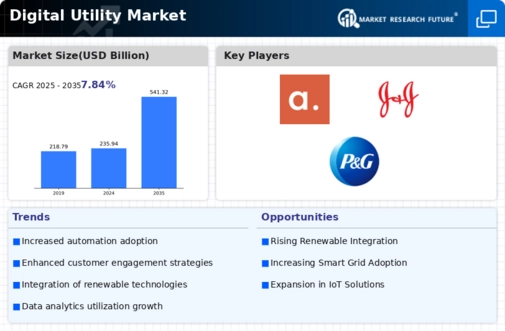Top Industry Leaders in the Digital Utility Market

The Competitive Landscape of the Digital Utility Market
The digital utility market is electrifying the energy landscape. With traditional giants merging with tech-savvy startups and innovative solutions disrupting established norms, understanding the intricate currents of competition is crucial for any player seeking to thrive in this dynamic ecosystem. By understanding the complex currents of competition, the strategies adopted by key players, and the crucial factors influencing market share, players can harness the power of technology and innovation to become a beacon of success in the digital utility market's electrifying future.
Key Player:
- Capgemini SA
- International Business Machine
- Corporation
- Accenture PLC
- Microsoft Corporation
- Cognizant Technology Solutions
- Corporation
- Cisco Systems Inc.
- Oracle Corporation
- SAP SE
- Siemens AG
- General Electric Company
- ABB Ltd.
Strategies Adopted by Key Players:
- Established Utilities: Renowned energy providers like Enel and Exelon leverage their vast customer base and brand recognition to adopt digital solutions gradually, integrating smart grids and customer portals into existing infrastructure. Enel, for example, champions renewable energy integration through its digital platforms.
- Tech Giants: Tech leaders like Google and Microsoft enter the fray by offering cloud-based solutions, data analytics platforms, and AI-powered grid management tools. Google Cloud, for example, provides advanced analytics for optimizing energy consumption and grid operations.
- Grid Technology Specialists: Companies like ABB and Siemens focus on core grid infrastructure, offering smart meters, advanced sensors, and communication technologies for real-time data collection and grid optimization. ABB, for instance, excels in microgrid solutions for distributed generation and energy resilience.
- Renewable Energy Champions: Companies like Ørsted and NextEra Energy prioritize digitalization within their renewable energy portfolios, integrating smart wind farms and solar energy systems with intelligent management platforms. Ørsted, for example, utilizes digital solutions to optimize wind farm performance and grid integration.
Factors for Market Share Analysis:
- Technology Breadth: Offering a comprehensive range of digital solutions, from smart grids and customer management platforms to data analytics and AI-powered optimization tools, influences market share.
- Industry Focus: Specialization in specific areas, such as grid modernization, energy efficiency, or renewable energy integration, caters to specific customer needs and attracts targeted market segments.
- Data Analytics and AI Integration: Leveraging advanced data analytics and AI capabilities for predictive maintenance, demand forecasting, and grid optimization differentiates players and improves operational efficiency.
- Cybersecurity and Data Privacy: Ensuring robust cybersecurity measures and data privacy compliance builds trust and opens doors to government contracts and regulated industries.
- Cost-Effectiveness and Return on Investment: Striking a balance between affordability and delivering tangible value through cost savings, increased efficiency, and improved customer experience is key for attracting budget-conscious buyers.
New and Emerging Companies:
Startups like GridBeyond and AutoGrid disrupt the market with innovative offerings. GridBeyond utilizes AI-powered platforms for virtual power plant management and grid balancing, while AutoGrid focuses on demand response solutions and transactive energy markets. These newcomers bring agility, specialized solutions, and data-driven insights, forcing established players to adapt and innovate.
Industry Development:
December 2023,
- Siemens is a leading provider of smart grid technologies, offering solutions for grid modernization, distributed energy integration, and energy efficiency. They recently partnered with a major utility company to deploy a smart grid pilot project aimed at improving grid resilience and reliability.
- Itron is a leading provider of smart meters and other advanced metering infrastructure (AMI) solutions. Their AMI solutions enable two-way communication between utilities and consumers, allowing for real-time energy monitoring and demand response programs.
